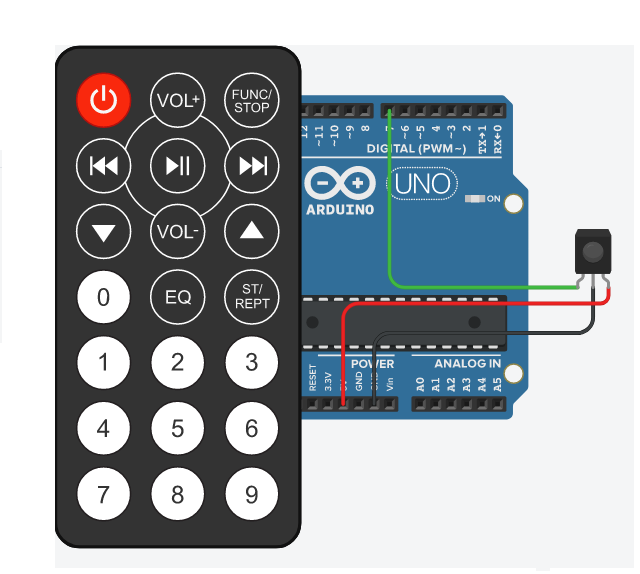Hardware components | ||||||
_ztBMuBhMHo.jpg?auto=compress%2Cformat&w=48&h=48&fit=fill&bg=ffffff) |
| × | 1 | |||
| × | 1 | ||||
 |
| × | 1 | |||
Software apps and online services | ||||||
 |
| |||||
We all know what IR signals are. And we can decode it. But I made this tutorial because in the IRremote.h(most popular IR library), the newest version the easiest mode to decode IR Signals is deprecated, and it took 3 days to find the another good one.
We use the same parts, but other code.
We need an IR Remote, IR receiver and... an Arduino
#include <IRremote.h>
#define MARK_EXCESS_MICROS 20 // recommended for the cheap VS1838 modules
//------------------------------------------------------------------------------
// Tell IRremote which Arduino pin is connected to the IR Receiver (TSOP4838)
//
int IR_RECEIVE_PIN = 11;
//+=============================================================================
// Configure the Arduino
//
void setup() {
pinMode(LED_BUILTIN, OUTPUT);
Serial.begin(115200); // Status message will be sent to PC at 9600 baud
#if defined(__AVR_ATmega32U4__) || defined(SERIAL_USB) || defined(SERIAL_PORT_USBVIRTUAL) || defined(ARDUINO_attiny3217)
delay(2000); // To be able to connect Serial monitor after reset or power up and before first printout
#endif
// Just to know which program is running on my Arduino
Serial.println(F("Starting " __FILE__ " from " __DATE__ "Using library version " VERSION_IRREMOTE));
Serial.println("For Pronto details type 'pronto'"); // 2 blank lines between entries
Serial.println("And for extra Pronto Details type 'prontodet'");
IrReceiver.begin(IR_RECEIVE_PIN, ENABLE_LED_FEEDBACK); // Start the receiver, enable feedback LED, take LED feedback pin from the internal boards definition
Serial.print(F("Ready to receive IR signals at pin "));
Serial.println(IR_RECEIVE_PIN);
}
//+=============================================================================
// The repeating section of the code
//
void loop() {
char ProntoHex = Serial.read();
if (IrReceiver.decode()) { // Grab an IR code
// Check if the buffer overflowed
if (IrReceiver.results.overflow) {
Serial.println("IR code too long. Edit IRremote.h and increase RAW_BUFFER_LENGTH");
} else {
Serial.println();
Serial.println();
IrReceiver.printIRResultAsCVariables(&Serial); // Output address and data as source code variables
IrReceiver.compensateAndPrintIRResultAsPronto(&Serial);
}
/*
* Example for using the compensateAndStorePronto() function.
* Creating this String requires 2210 bytes program memory and 10 bytes RAM for the String class.
* The String object itself requires additional 440 Bytes RAM from the heap.
* This values are for an Arduino UNO.
*/
}
IrReceiver.resume(); // Prepare for the next value
}
/*
* IRreceiveDump.cpp
*
* Dumps the received signal in different flavors.
* Since the printing takes so much time, repeat signals may be skipped or interpreted as UNKNOWN.
*
* Copyright (C) 2020-2021 Armin Joachimsmeyer
* armin.joachimsmeyer@gmail.com
*
* This file is part of Arduino-IRremote https://github.com/z3t0/Arduino-IRremote.
*/
/*
* You can change this value accordingly to the receiver module you use.
* The required value can be derived from the timings printed here.
* Keep in mind that the timings may change with the distance
* between sender and receiver as well as with the ambient light intensity.
*/
#define MARK_EXCESS_MICROS 20 // recommended for the cheap VS1838 modules
#include <IRremote.h>
//------------------------------------------------------------------------------
// Tell IRremote which Arduino pin is connected to the IR Receiver (TSOP4838)
//
#if defined(ESP32)
int IR_RECEIVE_PIN = 15;
#else
int IR_RECEIVE_PIN = 11;
#endif
//+=============================================================================
// Configure the Arduino
//
void setup() {
pinMode(LED_BUILTIN, OUTPUT);
Serial.begin(9600); // Status message will be sent to PC at 9600 baud
#if defined(__AVR_ATmega32U4__) || defined(SERIAL_USB) || defined(SERIAL_PORT_USBVIRTUAL) || defined(ARDUINO_attiny3217)
delay(2000); // To be able to connect Serial monitor after reset or power up and before first printout
#endif
// Just to know which program is running on my Arduino
Serial.println(F("START " __FILE__ " from " __DATE__ "\r\nUsing library version " VERSION_IRREMOTE));
IrReceiver.begin(IR_RECEIVE_PIN, ENABLE_LED_FEEDBACK); // Start the receiver, enable feedback LED, take LED feedback pin from the internal boards definition
Serial.print(F("Ready to receive IR signals at pin "));
Serial.println(IR_RECEIVE_PIN);
}
//+=============================================================================
// The repeating section of the code
//
void loop() {
if (IrReceiver.decode()) { // Grab an IR code
// Check if the buffer overflowed
if (IrReceiver.results.overflow) {
Serial.println("IR code too long. Edit IRremoteInt.h and increase RAW_BUFFER_LENGTH");
}
Serial.println(IrReceiver.decodedIRData.decodedRawData);
IrReceiver.resume(); // Prepare for the next value
}
}






Comments
Please log in or sign up to comment.